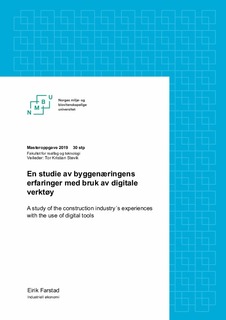| dc.contributor.advisor | Stevik, Tor Kristian | |
| dc.contributor.author | Farstad, Eirik | |
| dc.date.accessioned | 2019-08-21T12:34:31Z | |
| dc.date.available | 2019-08-21T12:34:31Z | |
| dc.date.issued | 2019 | |
| dc.identifier.uri | http://hdl.handle.net/11250/2609553 | |
| dc.description.abstract | «Det digitale veikartet til byggenæringen» er et overordnet rammeverk for hvordan næringen bør jobbe for å oppnå reduserte byggekostnader, raskere prosjektgjennomføring, effektiv drift og lavere klimagassutslipp. På bakgrunn av veikartet har Statsbygg innført digitale kontraktskrav. Det innebærer at all prosjektering skjer i bygningsinformasjons-modellen, og all informasjon skal genereres og hentes i bygningsinformasjonsmodellen. Dermed må byggeplassene være papirfri, og entreprenørene må benytte digitale verktøy.
Digitalisering av byggenæringen vekker forfatterens interesse og vil påvirke forfatterens arbeidsdager. På bakgrunn av dette søker masteroppgaven å svare på problemstillingen: Hvilke erfaringer har byggenæringen så langt med bruk av digitale verktøy? Problemstillingen blir besvart gjennom tre forskningsspørsmål:
1. Hvilke digitale verktøy benytter byggenæringen?
2. Hvilke utfordringer medfører digitaliseringen?
3. Hvilke gevinster medfører digitaliseringen?
Det ble gjennomført dybdeintervjuer av 13 informanter fordelt på tre ulike byggeprosjekter. Informantenes svar ble også kvantifisert gjennom en spørreundersøkelse om de digitale verktøyene.
Resultatene viser at byggenæringen ser mange fordeler ved å benytte seg av digitale verktøy. Verktøyene forenkler og forbedrer store deler av byggeprosessen gjennom bruk av bygningsinformasjonsmodell, BIM-kiosk, digitale håndholdte enheter, drone, digital simulator, digital oppslagstavle, automatisering, utvidet virkelighet, virtuell virkelighet, radiofrekventidentifikasjon og QR-koder. Samtidig er enkelte verktøy og programvarer underutviklet og krever forbedring dersom næringen skal ha nytte av dem. Studien viser også at god bruk av digitale verktøy krever enkelte forutsetninger. I tillegg behøves det en omstilling hos menneskene som skal benytte dem. | nb_NO |
| dc.description.abstract | “The digital road map for the construction industries” is a broad framework outlining how the construction industries should work toward reducing expenditures and emissions, whilst improving completion speed and efficiency of operations. Based on this roadmap, the Norwegian Directorate of Public Construction and Property (Statsbygg) has introduced into its contracts a requirement that planning be done through building information modelling (BIM), which allows for generation and retrieval of information throughout any project. As a result the construction sites are paperless, with contractors employing digital tools for all stages.
This digitising process is of great personal and professional interest, as it has the potential to fundamentally impact the average working day and future development in the field. This master’s thesis aims to investigate what the experience of digitising has been in the construction industries so far. This is done through three main questions:
1. Which digital tools are used?
2. What are the challenges faced as a result of digitising?
3. What are the benefits of digitising?
In-depth interviews have been carried out with 13 informants from three separate construction projects. Their answers were also quantified through a questionnaire about the digital tools.
The results show that the construction industries see many advantages of utilising digital tools, which simplify and improve many aspects of construction processes through BIM, «BIM-kiosk», handheld digital devices, drones, simulations, digital bulletin boards, automation, augmented reality and virtual reality, radio frequency identification (RFID), and QR-codes. However, some tools and software are underdeveloped, and will require further improvement in order to be beneficial to the construction industries. The study also shows that there are certain prerequisites to the successful use of digital tools, including training and adjustments for the people who aim to make use of them.
| nb_NO |
| dc.language.iso | nob | nb_NO |
| dc.publisher | Norwegian University of Life Sciences, Ås | nb_NO |
| dc.rights | Attribution-NonCommercial-NoDerivatives 4.0 Internasjonal | * |
| dc.rights.uri | http://creativecommons.org/licenses/by-nc-nd/4.0/deed.no | * |
| dc.subject | Digitale verktøy | nb_NO |
| dc.subject | Digital construction sites | nb_NO |
| dc.subject | Digitale byggeplasser | nb_NO |
| dc.title | En studie av byggenæringens erfaringer med bruk av digitale verktøy | nb_NO |
| dc.title.alternative | A study of the construction industry´s experiences with the use of digital tools | nb_NO |
| dc.type | Master thesis | nb_NO |
| dc.source.pagenumber | 103 | nb_NO |
| dc.description.localcode | M-IØ | nb_NO |

